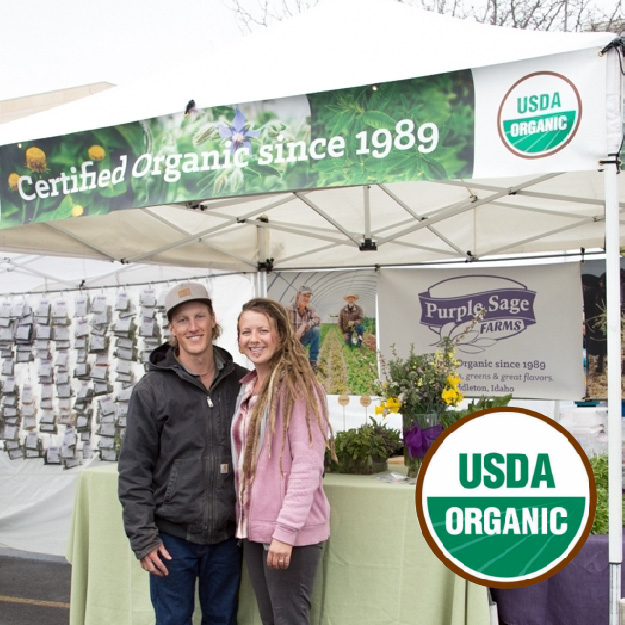Producer

Purple Sage Farms
Contact: Tim Sommer and Tamara Sloviaczek
Address: 11741 Bullock Rd Middleton, ID, 83644
Phone: 208-585-6140
Website: www.purplesagefarms.com
About Us
For over 30 years, Purple Sage Farms has specialized in growing a wide range of organic herbs, greens and vegetables. Today, that has expanded to over 250 varieties of crops ranging from the familiar and traditional to the obscure and exotic, whether they are culinary, medicinal or both. Purple Sage Farms greens and salad mixes change with the seasons and include a wide variety of colors, flavors, and shapes. Among all of the crops, nutrients are high and flavors are prominent. Purple Sage Farms herbs, spices, greens and vegetables are thoughtfully grown and proudly certified organic on our family farm in Middleton, Idaho.
Practices
Our mission at Purple Sage Farms is to connect our community to the healthiest, freshest, and most flavorful food. Organic practices guide how we care for our crops, from diverse crop rotation practices to how we harvest the freshest herbs and greens. Purple Sage Farms is an ecosystem and each part plays a role.
Our farming practices start with promoting diversity and abundance of microbes in the soil. We raise livestock for meat and the animal manure is composted to make fertilizer for plants. We build soil structure and microbe communities by tilling the soil as little as possible. Plant beds get a rest with restorative cover crops.
Fresh, local produce is a cornerstone of our farm. We’ve also learned that harvesting and drying those fresh herbs, at the peak of their quality, assures that their great flavors are preserved for use during the cold winter months. Buying fresh when it’s available, and switching to preserved when fresh is no longer available is the most sustainable way to eat.
Our first season starts in early January, inside our germination room, with trays of seedlings waiting for a warmer date to place inside our greenhouses or outside under protective covers. By March, perennials and overwintered greens are waking up from winter dormancy and seedlings are growing fast. As summer approaches, a shift occurs to heat-loving plants that thrive in the outdoor sunshine or greenhouse humidity. Cool-season crops are planted in August to be harvested September through December. Then a fourth season becomes important when fermented and dried crops that were harvested the rest of the year are made in our on-farm commercial kitchen. This completes the year, with local food available in every month.
Our farming practices start with promoting diversity and abundance of microbes in the soil. We raise livestock for meat and the animal manure is composted to make fertilizer for plants. We build soil structure and microbe communities by tilling the soil as little as possible. Plant beds get a rest with restorative cover crops.
Fresh, local produce is a cornerstone of our farm. We’ve also learned that harvesting and drying those fresh herbs, at the peak of their quality, assures that their great flavors are preserved for use during the cold winter months. Buying fresh when it’s available, and switching to preserved when fresh is no longer available is the most sustainable way to eat.
Our first season starts in early January, inside our germination room, with trays of seedlings waiting for a warmer date to place inside our greenhouses or outside under protective covers. By March, perennials and overwintered greens are waking up from winter dormancy and seedlings are growing fast. As summer approaches, a shift occurs to heat-loving plants that thrive in the outdoor sunshine or greenhouse humidity. Cool-season crops are planted in August to be harvested September through December. Then a fourth season becomes important when fermented and dried crops that were harvested the rest of the year are made in our on-farm commercial kitchen. This completes the year, with local food available in every month.
